Introduction to Bolognese Sauce
Bolognese sauce isn’t just another pasta topping; it’s a culinary classic that transforms any simple dish into a hearty feast. For young professionals juggling busy schedules, mastering how to make Bolognese sauce at home can be a game changer. Imagine coming home after a long day and treating yourself to a rich, savory meal that fills your kitchen with the irresistible aroma of simmering meat and vegetables.
When you choose homemade over store-bought, you're not just saving money; you're also in control of the ingredients. Stores often skimp on quality, but crafting your own Bolognese allows you to select fresh vegetables and high-quality meats. Plus, the satisfaction of creating a meal from scratch can be incredibly rewarding. According to a study by the USDA, preparing your meals can even lead to healthier eating habits.
Want to impress friends at your next gathering? A well-made Bolognese sauce shows off your culinary skills without the need for intricate techniques. Simply follow our recipe, and in a few hours, you’ll have a flavor-packed sauce that’s perfect with your favorite pasta. Let's dive into the step-by-step guide and unlock the secrets of this timeless dish!
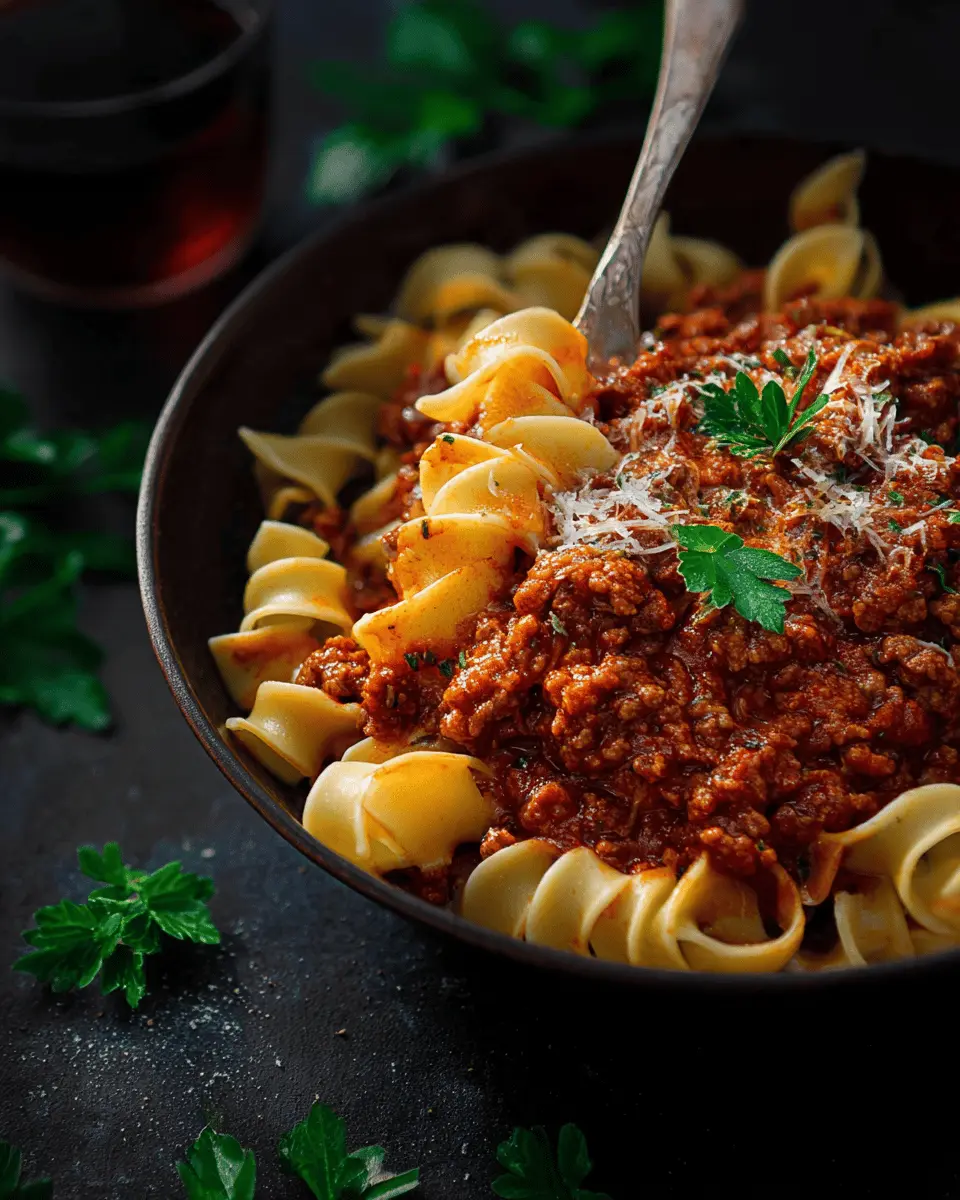
Ingredients for Bolognese Sauce
Essential ingredients for a rich Bolognese
Creating a hearty Bolognese sauce requires a thoughtful selection of ingredients. Here’s what you’ll need to build a flavorful base:
- 1 tablespoon extra-virgin olive oil
- 2 tablespoons butter
- 1 large onion, finely chopped
- 2 large carrots, finely chopped
- 2 celery stalks, finely chopped
- 3 cloves garlic, chopped
- 4 ounces turkey bacon, diced (for a tasty twist)
- 1 pound ground beef (20% fat)
- Salt and freshly ground pepper, to taste
- 1 (28 ounces) can peeled San Marzano tomatoes, hand-crushed
- 1 cup whole milk
- ½ teaspoon freshly grated nutmeg
These ingredients combine to create a rich and velvety sauce that pairs beautifully with pasta.
Optional ingredients for flavor enhancement
To elevate your sauce even further, consider adding these optional ingredients:
- 1 cup heavy cream (to enrich the texture)
- 1 cup grated Parmesan cheese (Parmigiano Reggiano recommended)
- ½ cup chopped parsley (for a fresh finish)
Including these extras can enhance the flavor while maintaining that authentic Italian essence. For tips on how to make Bolognese sauce that truly impresses, check out this guide!
Preparing Bolognese Sauce
Making a delicious Bolognese sauce is both an art and a science, and you can create a restaurant-quality dish right in your own kitchen. Here’s how to make Bolognese sauce, step by step.
Gather and prepare your ingredients
Before you dive into cooking, take the time to gather all your ingredients. This makes the process smoother and more enjoyable. Here’s what you’ll need:
- 1 tablespoon extra-virgin olive oil
- 2 tablespoons butter
- 1 large onion, finely chopped
- 2 large carrots, finely chopped
- 2 celery stalks, finely chopped
- 3 cloves garlic, chopped
- 4 ounces pancetta, diced
- 1 pound ground beef (20% fat)
- 1 pound ground turkey
- Salt and freshly ground pepper, to taste
- 1 cup low-sodium chicken broth
- 1 (28-ounce) can peeled San Marzano tomatoes, hand-crushed
- 1 cup whole milk
- ½ teaspoon freshly grated nutmeg
- 1 cup heavy cream, optional
- 1 cup grated parmesan cheese (Parmigiano Reggiano is the best!)
- ½ cup chopped parsley
Preparation is key! Make sure all your veggies are diced, and your meats are ready to go. This saves you from scrambling mid-cooking.
Sauté the soffritto for depth of flavor
With the right ingredients in hand, it’s time to add that crucial depth of flavor. Heat a large Dutch oven over medium-high heat. Add the olive oil and butter until melted, then toss in your finely chopped onion, carrots, and celery. This aromatic mix, known as soffritto, needs about 5 to 8 minutes to soften and slightly caramelize. Don’t forget the garlic! Add it for the last couple of minutes for that fragrant note.
Brown the meats to maximize flavor
Next, you want to infuse your sauce with rich flavors by browning the meat. Add more olive oil if needed, then toss in the diced pancetta until golden. Remove this and then work in batches to brown the ground beef and turkey. Season with salt and fresh pepper and resist the urge to stir too often—let those brown bits stick! This step helps develop a flavorful base that makes your sauce truly shine.
Deglaze the pan like a pro
Once the meat is browned and the savory goodness is stuck to the bottom of the pot, it’s time to deglaze. Return the cooked pancetta and soffritto to the pan, and then pour in your chicken broth. Take a wooden spoon and scrape up those delicious bits. Cook until the broth has mostly evaporated—this should take about 2 to 3 minutes. Then, stir in the crushed tomatoes, milk, nutmeg, and more seasoning.
Simmer to perfection
Now, patience is key! Bring your sauce to a boil, then reduce to a gentle simmer. Cover and cook for 3 to 4 hours, stirring occasionally. This slow simmer melds all the flavors together beautifully. If your sauce is still too runny after this time, simply turn up the heat, occasionally stirring until it thickens.
Bolognese sauce is all about the love and time you invest in it. So, grab a glass of water, put on your favorite tunes, and let the aroma of homemade sauce fill your space. You’ll soon savor a hearty meal that’s truly worth the wait!
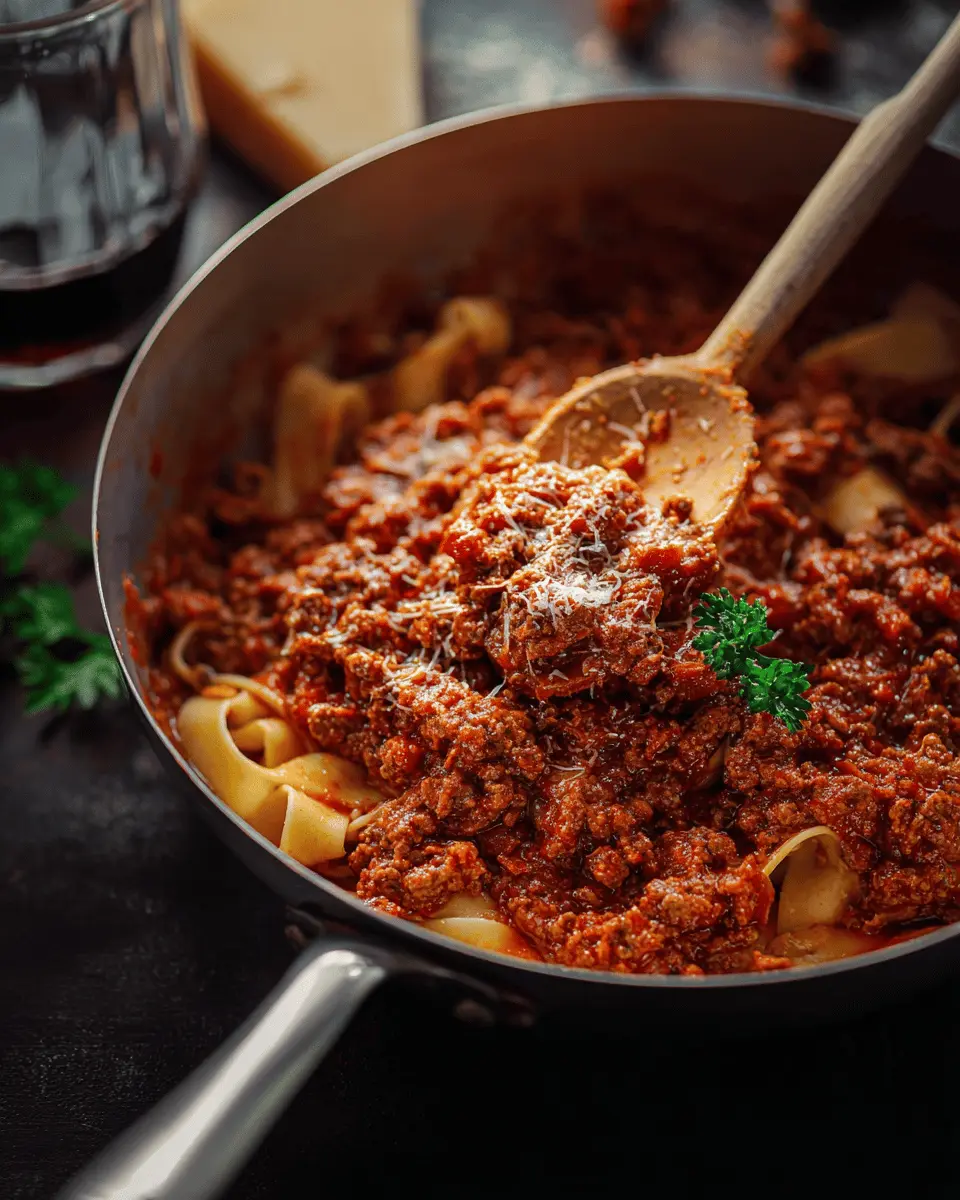
Variations on Bolognese Sauce
Classic Bolognese with a Twist
For those yearning for a classic Bolognese sauce but looking for a little flair, try adding some sautéed mushrooms or a splash of vegetable broth! These ingredients can enhance the depth, providing a rich complexity that’ll impress your dinner guests. Have you ever thought of swapping ground beef for your favorite protein, like turkey or even chicken? This small change can make all the difference in flavor and texture!
Vegetarian Bolognese for Meatless Meals
Craving the essence of Bolognese but want a meatless alternative? A vegetarian version can be just as satisfying! Replace the meats with lentils or finely chopped veggies like zucchini and eggplant. Add crushed walnuts for that hearty, meaty texture! For guidance on how to make Bolognese sauce without meat, check out this resource from the BBC. It's a wonderful way to enjoy a comforting classic without sacrificing flavor!
Cooking Tips and Notes for Bolognese Sauce
The secret to the perfect simmer
To achieve a rich, flavorful Bolognese sauce, patience is key. After bringing your sauce to a boil, lower the heat to a gentle simmer. This allows the flavors to meld beautifully over time. Ideally, aim for a simmer of at least 3 hours; this slow cooking process transforms your ingredients into a harmonious, savory delight. Stir occasionally, but not too much—let the meat brown and develop that delicious crust some of us crave.
Must-have kitchen tools for ease
Invest in a solid Dutch oven for your sauce-making adventures. Its heavy base distributes heat evenly, ensuring nothing sticks or burns. Additionally, a wooden spoon is perfect for gentle stirring and scraping those tasty bits off the bottom—ever heard of fond? While you're here, don’t forget to grab a good-quality can opener for those San Marzano tomatoes; they really are the star of the show when you're learning how to make bolognese sauce.
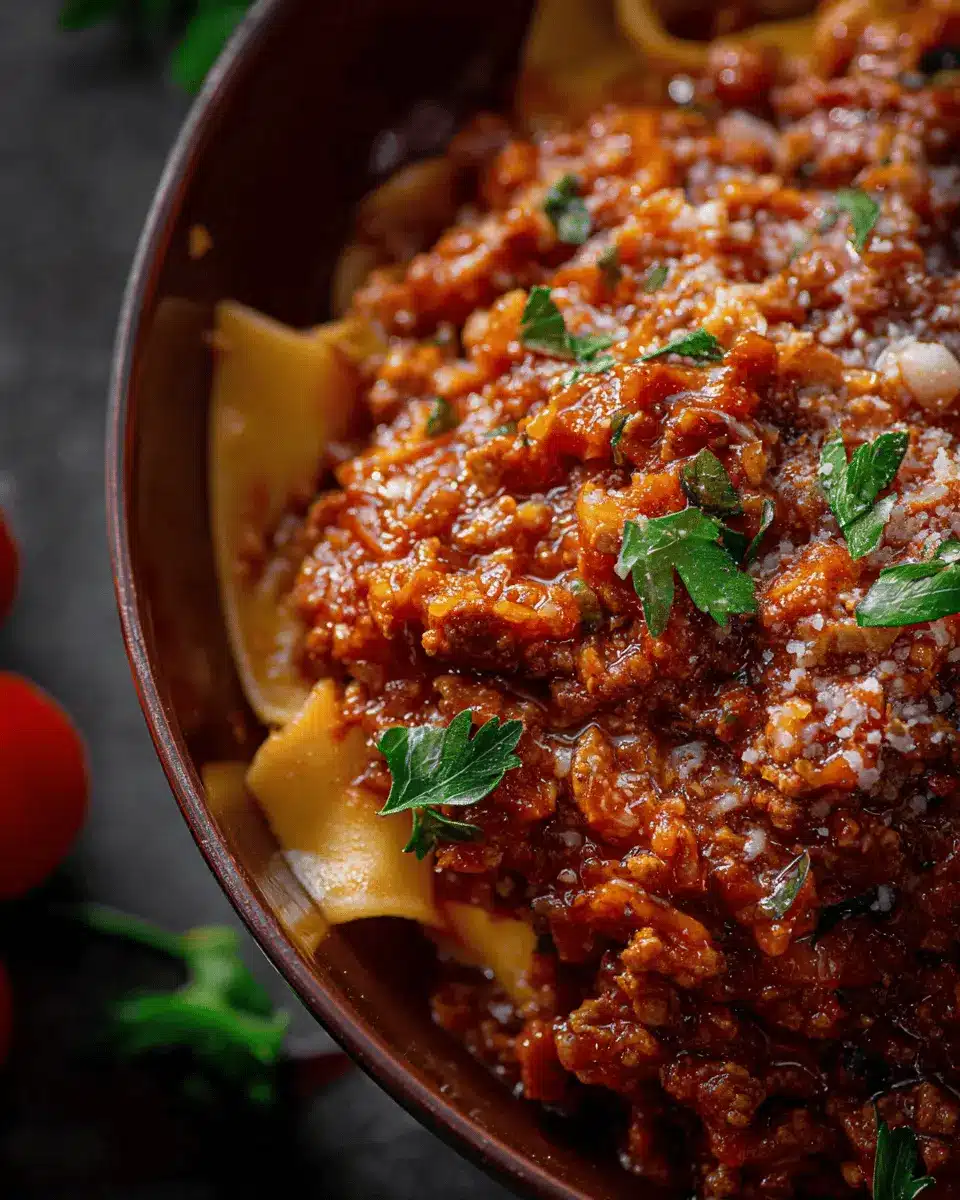
Serving Suggestions for Bolognese Sauce
Best pasta to pair with your sauce
When pondering how to make Bolognese sauce truly shine, consider using wide noodles. Tagliatelle and pappardelle are classics that effortlessly hold the rich sauce, delivering a perfect bite every time. If you're looking for something a little different, fettuccine or even gnocchi can add a fun twist, letting the sauce cling beautifully. Don't forget to finish with an extra sprinkle of grated Parmigiano Reggiano for that authentic Italian touch!
Creative ways to use leftover Bolognese
Don't let any of that delicious Bolognese go to waste! Here are a few delicious ideas:
- Stuffed Peppers: Mix leftover sauce with cooked rice, stuff into bell peppers, and bake until tender for a hearty meal.
- Lasagna: Layer it between sheets of pasta, ricotta, and mozzarella for an indulgent twist on a classic.
- Pizza Topping: Spread a thin layer on your pizza crust for a meaty delight.
- Casserole: Combine with pasta and cheese for a creamy, baked delight.
Feel free to explore these options and enjoy a new take on your favorite sauce!
Time Breakdown for Bolognese Sauce
Preparation Time
Give yourself about 30 minutes to prepare. This is the time you’ll need for chopping vegetables and measuring out your ingredients. Make sure to finely chop the onions, carrots, and celery for that perfect flavor blend!
Cooking Time
The cooking process takes approximately 3 to 4 hours. This long simmering time allows the flavors to develop fully, resulting in a deeply rich and satisfying sauce that’s worth the wait.
Total Time
In total, you’re looking at around 3.5 to 4.5 hours from start to finish. While this might seem lengthy, imagine the delightful aromas filling your kitchen and the delicious meal awaiting you! Perfect for a cozy weekend dinner with friends or family.
For a visual guide on how to make Bolognese sauce, try checking out this article that walks through the steps!
Nutritional Facts for Bolognese Sauce
Calories
A serving of this rich and hearty Bolognese sauce packs about 588 calories. It’s a filling dish that can keep you satisfied.
Protein
You'll get a robust 28 grams of protein per serving, making it a great option for fueling your active lifestyle.
Fat Content
With 47 grams of fat, this sauce is indulgent, offering a balance of saturated and unsaturated fats that can enhance flavor and satisfaction.
FAQs about Bolognese Sauce
What is the best meat to use for Bolognese?
When it comes to crafting the perfect Bolognese sauce, a combination of meats really elevates the flavor profile. Traditionally, a mix of ground beef and ground pork offers a great balance of richness and tenderness. For a leaner alternative, you might consider using ground turkey or chicken, but remember that these options will yield a slightly different taste and texture. Always go for higher fat content in your meat (about 20%) to keep the sauce deliciously rich.
Can Bolognese sauce be made in advance?
Absolutely! In fact, Bolognese sauce often tastes even better the next day after the flavors have had time to meld together. You can prepare it ahead of time and store it in the refrigerator for up to three days or freeze it for up to three months. Just be sure to reheat it gently when you're ready to serve.
What can I substitute for the heavy cream?
If you'd like to skip the heavy cream while still achieving a creamy texture, consider using half-and-half or a plant-based alternative like almond milk blended with a bit of cornstarch. Full-fat coconut milk also adds richness without dairy. Choose based on what suits your tastes and dietary preferences best!
Conclusion on Bolognese Sauce
Learning how to make Bolognese sauce is a rite of passage for young professionals. This hearty dish not only impresses at dinner parties but also brings warmth and comfort to weeknight meals. With practice, you’ll perfect your unique flavor, making this classic sauce a staple in your kitchen.
Why Every Young Professional Should Master Bolognese
Bolognese sauce is more than just a recipe; it's the essence of culinary confidence. Mastering this sauce can elevate your cooking skills and impress friends and family alike. In today's fast-paced world, preparing a single pot of hearty sauce allows for quick meals throughout the week. With adaptability in mind, you can swap proteins or veggies based on what's in season or your dietary needs. Plus, the comforting aroma of simmering Bolognese will make your home feel welcoming and inviting.
Investing time in learning how to make Bolognese sauce not only enhances your culinary repertoire but also offers ample opportunity to enjoy cozy evenings with friends over pasta. Whether you're hosting a casual gathering or simply treating yourself, this sauce is a reliable go-to. So grab your apron and start cooking—your taste buds (and your guests) will thank you!
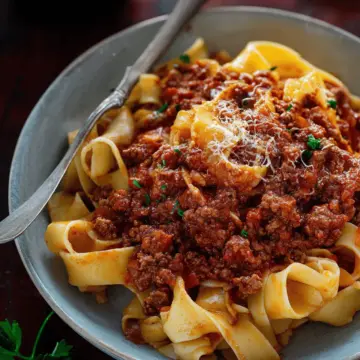
How to Make Bolognese Sauce: A Delicious Turkey Bacon Twist
Equipment
- Dutch Oven
Ingredients
Base Ingredients
- 1 tablespoon extra-virgin olive oil
- 2 tablespoons butter
- 1 large onion finely chopped
- 2 large carrots finely chopped
- 2 stalks celery finely chopped
- 3 cloves garlic chopped
- 4 ounces pancetta diced
- 1 pound ground beef (20% fat)
- 1 pound ground pork
- Salt to taste
- Freshly ground pepper to taste
- 1 cup dry white wine
- 1 can (28 ounces) peeled San Marzano tomatoes hand crushed
- 1 cup whole milk
- ½ teaspoon freshly grated nutmeg
- 1 cup heavy cream optional (see notes)
- 1 cup grated parmesan cheese Parmigiano Reggiano is the best!
- ½ cup chopped parsley
Instructions
Cooking Steps
- Heat olive oil and butter in a large Dutch oven, over medium high heat, until the butter is melted. Add onion, carrots, and celery, and sauté until softened and beginning to caramelize, 5 to 8 minutes. Add garlic and sauté for another couple of minutes, until fragrant. Season with salt and pepper and, using a slotted spoon, remove the soffritto to a plate and reserve.
- Add more olive oil, if needed, and add the pancetta. Cook until golden brown, about 5 minutes. Remove pancetta and reserve. Working in 2-3 batches so not to over crowd the pot, add ground beef and pork. Season with salt and pepper and cook, breaking lumps with a wooden spoon but resisting the urge to stir too often, until browned, about 10 – 15 minutes.
- Return the reserved soffritto and pancetta to the pot. Add the white wine and deglaze the pan, scraping all the browned bits stuck to the bottom. Cook until the wine is mostly evaporated, about 2 to 3 minutes. Stir in the crushed tomatoes, milk, nutmeg and a pinch of salt and pepper. Bring to a boil and then lower the heat to a simmer.
- Cover and cook, stirring occasionally, for 3 to 4 hours or until the liquids have reduced and the sauce is thick. If the sauce is still too liquid-y, you can turn the heat up and boil – stirring frequently – until it reduces.
- Stir in heavy cream, parmesan cheese and parsley. Stir vigorously to emulsify. Taste for seasoning and adjust salt and pepper, if necessary.
- Serve, tossed with a wide pasta, like tagliatelle or pappardelle.




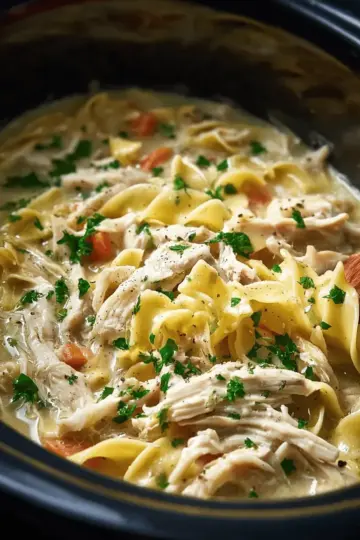
Leave a Reply